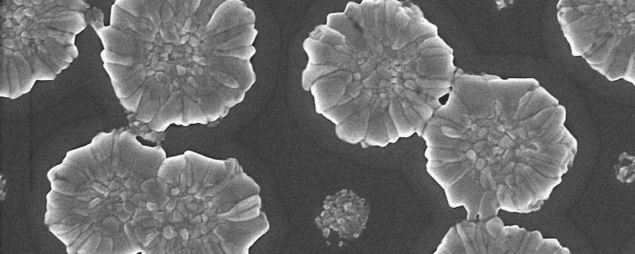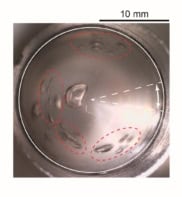
Why are halide perovskites so efficient at converting sunlight into energy? New single-particle measurements have revealed that low-energy states lying below the bandgap of these materials may be the reason. The work could help more accurately design improved perovskite materials for solar cell applications.
Halide perovskites have the chemical formula ABX3 (where A is typically methylammonium, formamidinium or caesium, B is lead or tin, and X iodine, bromine or chlorine). They are one of the most promising thin-film solar-cell materials available today because they can absorb light over a broad range of solar-spectrum wavelengths. They also have a low exciton (electron-hole) binding energy and high charge-carrier mobility. Indeed, the power-conversion efficiency (PCE) of solar cells made from perovskites has soared from just 3% to more than 22% in the last five years. This means that their PCE is now comparable to that of silicon-based solar cells.
Despite such impressive progress, researchers are still unsure as to why these materials are so efficient at converting sunlight into energy. One theory suggests that energetically stabilized states involving polarons (quasiparticles in which electrons and holes carry phonons) are responsible. However, direct evidence of such particles, or indeed other low-energy states (which should lie below the bandgap of the material and show up in photoluminescence measurements) were lacking until now.
Free from traps and defects
A team led by Elad Harel of Northwestern University in the US has used a technique called single-particle transient absorption microscopy on the halide perovskite MAPbI3 (where MA is methylammonium) to identify such sub-bandgap states directly for the first time. These states become rapidly populated by charge carriers when the material is excited with light. The researchers also suspect that they are free from traps and defects, which can adversely affect the power-conversion efficiency of these thin film materials.
The technique used by Harel’s team is very different to traditional spectroscopic methods used to study perovskites and related photovoltaic materials that average out the photoluminescence spectra of thousands of single particles. “These techniques only measure the average physical properties of a material whereas a single-particle approach, like the one we used in our work, provides not only the average properties but how these properties are distributed as well,” explains Harel.
A distorted view of reality
“Imagine that we were only able to measure the average temperature of our planet, rather than the spatial distribution of temperatures,” he says. “Such measurements would lead us to think that every location on Earth was at 14°C, which is clearly a distorted view of reality – it is below freezing in Chicago right now, but over 30°C in Sudan.
“It is the same for heterogeneous materials like perovskite thin films: the carrier properties may vary across even a few microns in space and single-particle measurements allow us to see features that are normally hidden in the ensemble. Such measurements were key to identifying the low-energy states that we observed.”
The work proves that average properties do not give us the full picture of what is happening at the nanoscale, he tells nanotechweb.org. Such an incomplete picture means that we may put forth physical mechanisms that are simply wrong and then use these incorrect mechanisms to try and fabricate improved materials. This not only leads us down the wrong path but also wastes tremendous resources – time, money and energy.”
Towards a holistic picture of carrier transport
The researchers say that they are now busy studying a wider range of 2D and 3D perovskites with their colleagues in Mercouri Kanatzidis’ lab at Northwestern. “We are now able to correlate the transient absorption microscopy results with high-resolution scanning measurements to find out how specific structures in these materials affect charge-carrier behaviour,” says Harel.
“We need a holistic picture of carrier transport so that we can produce a correct and consistent mechanistic picture of perovskites. This, we believe, will ultimately translate into improved solar cell materials down the road.”
The research is detailed in Nano Letters DOI: 10.1021/acs.nanolett.7b04078.



